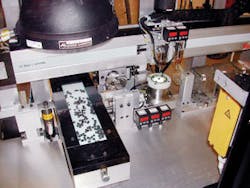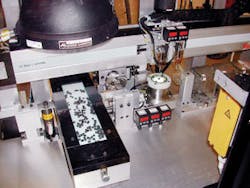Automated inspection of microparts requires vision
A discussion with Nol Brouwers, IMS
VSD: Can you provide some background information on IMS? How are you using machine-vision components and systems?
Brouwers: IMS was founded in 1999 as a spin-off of Texas Instruments (TI) Holland. As part of TI it was the mechanization group that developed manufacturing lines for new products such as automotive sensors, miniature bimetal switches, connectors, and RFID tags.
Now IMS designs and builds production systems for the high-precision electronics and medical industries. We specialize in microassembly and testing of small, complex parts such as speakers for hearing aids, pressure sensors for the automotive industry, connectors used in mobile phones, and medical devices. In microassembly, IMS uses vision components and systems to monitor operations in line and to check processes and process quality.
In these markets we help our customers who have developed a product in a laboratory environment to make it suitable for manufacturing by a design-for-assembly step. We develop the manufacturing processes and a prototype line on which we can build the first series. From there on we can build the right automation system, and, if our customers do not have the right industrial experience, we can run those lines for them.
VSD: How do you approach a new customer? Do you work with OEMs or other system integrators?
Brouwers: IMS delivers customized equipment for new products. Through concurrent engineering, production solutions are developed, which often implies being involved in design for assembly, process development, industrialization strategy, equipment concept and design, equipment realization and qualification, pilot production activities, equipment transfer and installation, and equipment service and support. We are system integrators, often working closely with OEMs.
In addition, IMS is a member of microsystem technology organizations such as IVAM (Dortmund, Germany; www.ivam.de), and we participate in industrial fairs such as the Hannover Messe and MOTEK. When a customer needs a new manufacturing line or new manufacturing or test equipment, we like to discuss the right solution based on understanding his business. With this information we will prepare an optimal proposal with all the data needed to make a decision.
VSD: What technologies and components does IMS sell or use in these applications?
Brouwers: In our Vision Inspection Feeding System (VIFS) we use our Pro-Micro basic frame, standard Bosch Rexroth (Lorh am Main, Germany; www.boschrexroth.com) components for parts handling, a vacuum system, and cameras for the vision functions. For vision applications we are an application house for dedicated image-recognition software. It usually takes little effort to customize the VIFS system to specific customer applications.
The VIFS started as a technology development project in 2004, together with the University of Twente (Enschede, The Netherlands; www.utwente.nl ) and Bosch Rexroth. At that time we could not find a reliable solution for feeding microparts on the market. Bowl feeders, for example, cannot be used due to adhesive forces or because the shape of the component is not suitable for reliable sorting.
The VIFS has a modular buildup in functionality. The standard system offers a solution for the orientation, selection, rotation, inspection (on dimensions and tolerances), and supply of microparts. Customer specific requirements regarding visual checks can easily be added to the software toolbox. Because the system is built up with standard components, the system is open, generic, and flexible. By changing the software, the same system can be used with different components. For 70% to 80%of the applications a standard vacuum gripper can be used, but sometimes sensitiveness, shape, or material of the part calls for a dedicated gripper. Alternatives include freezing the part to the gripper. IMS is researching this method together with the Technical University of Delft (Delft, The Netherlands; www.tudelft.nl).
Small parts are randomly supplied to the system on an input tray. This tray is lighted from the top by a dome. Depending on the product, different kind of colors are used for this lighting. By geometric shape recognition, the position, orientation, and rotation of the products on the input tray are determined. For product identification and inspection, the system uses the MIL software library from Matrox Imaging (Dorval, QC, Canada; www.matrox.com/imaging). To optimize cycle time and increase efficiency, the input tray may be vibrated to reposition the parts.
The part is picked up, oriented, and rotated so it can be positioned accurately on the inspection unit. For a second inspection, an image is taken from top, this time using a backlight and geometric shape recognition. Inspection can be done very accurately, by zooming in on a very small field of view. With the data acquired the product is rotated and corrected in the y direction, so the product is positioned in the centre of the field of view. Again an image from top is taken to measure part dimensions with vision metrology.
VSD: In which areas do you see the most growth? What are users demanding from you in the design of new systems?
Brouwers: IMS focuses on micro-assembly for microsystem applications such as MEMS. These applications are growing in industries such as automotive, consumer electronics, medical, life sciences, cosmetics, and RFID. Microassembly has a lot of new challenges with respect to automation and needs a different approach and development of new technologies. IMS integrates technology when it is available on the market and develops it if it is not. The VIFS is an example of technology that needed to be developed to tackle issues in the supply of microparts.
VSD: How is each OEM component more or less important for the applications that you serve?
Brouwers: IMS integrates components. Sometimes customers have a preference in brand, sometimes we use a brand because of our experience with it, and sometimes we choose a brand based on its unique specifications. In the case of the VIFS, we chose to build it up out of off-the-shelf components so that the only custom components are our software and the gripper.
VSD: What could vision-equipment manufacturers do to make your implementation jobs easier?
Brouwers: Our work would be easier if we had easier interfacing, quicker processing of data/image intake, and higher-resolution cameras. The image processing still takes a significant amount of time if we perform high-precision measurements. If we do a measurement with an accuracy of less than 10 µm, it still takes several seconds. In a manufacturing environment, cycle times of several seconds might be problematic as the production volumes are high.
VSD: What kinds of new applications do you expect to emerge? In which areas do you expect to see the most growth?
Brouwers: We expect to see ongoing miniaturization combined with increasing functionality, new applications enabled by microsystem technology, and increasing need for cost-effective manufacturing in microassembly applications. As surface-mount technology parts often cannot be seen by the human eye, we will rely on vision-based automated assembly operations. Today it is mainly a 2-D world, but in the next phase it will be a world of 3-D applications, as well.
VSD: How will OEM components targeted toward machine-vision applications have to change to meet future needs?
Brouwers: In the medical and pharmaceutical industries, parts have to be manufactured in a sterile environment. Manual handling for higher-volume products is not feasible. As new medical products can be small, their basic costs can be low. The feasibility of their success in the market will depend on high-tech automation. This automation-and the related quality inspection-will largely be dependent on the availability of the right vision, feeding, handling, and inspection systems.
Nol Brouwers is director of Integrated Mechanization Solutions (IMS), Almelo, The Netherlands; www.ims-nl.com. Editor in chief Conard Holton spoke with him about microassembly and the role of vision.


